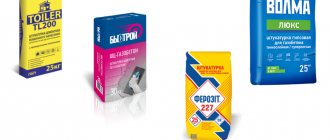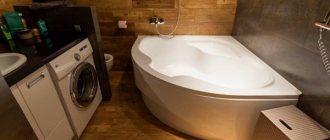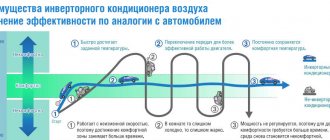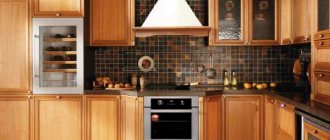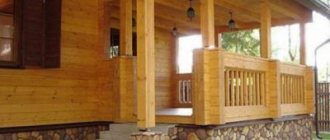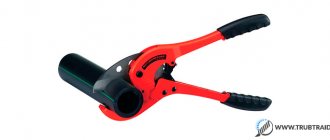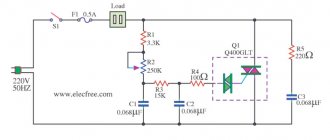Wall covered with plaster
During the renovation process, plastering walls with cement mortar is an important part of finishing the room. Despite its simple composition, this solution is able to reliably hide wall imperfections. In this way, structures in old houses with brick or concrete walls are strengthened. Plaster is used to improve the thermal insulation and fire resistance of premises. This material is often used due to its moderate cost, and a wide choice of further decoration ensures that plaster is in demand in the field of construction and renovation.
Advantages of using the mixture
Plaster material has certain advantages:
- the surface is able to resist the effects of water, dries quickly after getting wet, without deteriorating its properties;
- excellent vapor permeability ensures a comfortable indoor microclimate;
- the material is environmentally safe and meets all hygienic and sanitary requirements;
- with the help of such a mixture it becomes possible to change the decor style;
- the composition fully complies with fire safety requirements;
- low cost and low expenses associated with organizing plastering work;
- provides additional protection from extraneous noise.
The plastered surface gets a presentable appearance, and it becomes possible to perform finishing with various materials - wallpaper, paint, etc.
In addition to the listed advantages, developers also note a number of disadvantages of the material:
- During the operational period, cracks may form on the surface of the plaster layer. This is associated with shrinkage of the structure or violations committed in the technology of making the mortar and carrying out plastering work;
- working with such a mixture is allowed only at positive temperatures;
- plastering walls with cement-sand mortar involves preliminary preparation of the walls - installing a reinforcing layer, applying notches, priming;
- the work is performed manually, which takes a lot of time;
- According to established construction standards, it is allowed to apply a layer of plaster of a certain thickness.
Disadvantages of the composition
The inclusion of polyvinyl acetate in traditional putty provided it with several weak points. These include the following:
- Restrictions on places of use. Such coatings are not recommended for use in rooms with high humidity or where tiling is planned.
- Long drying period. As already noted, PVA-based putty undergoes a polymerization period of about a day, while traditional compounds can dry in a few hours, which reduces the time for carrying out work activities.
- High training requirements. PVA glue is extremely sensitive to the condition of the surface on which it is applied.
Therefore, it will be possible to achieve high adhesion only if the surface being treated is carefully processed.
Necessary equipment
Before plastering the walls, it is recommended to prepare everything you need to complete the work. The kit looks like this:
- trowel or ladles;
- rule;
- grater and grater;
- construction level;
- lighthouses;
- a shovel and a container of a suitable size for making a batch (for large volumes of work, it is allowed to use a concrete mixer);
- buckets;
- spray bottle for moistening walls;
- fishing line or cord;
- hammer, chisel, brushes.
Priming
The first step is to install the reinforcing mesh. This can be a chain link or a painting net, for wooden surfaces - shingles. The products are stretched onto the wall and secured with self-tapping screws around the perimeter and in the center. Then, use a wide spatula to scoop up more mortar and transfer it to the wall. Thus, the gap between the two beacons is filled, after which they take the rule and level the solution, moving the tool from bottom to top, while making zigzag movements. Then they go through the rule again. The plaster is left to dry and gain strength, which can take 7-10 days.
The second layer of plaster is applied to the reinforcing mesh
Preparing the walls
This stage is always performed, because the solution is applied in a thick layer, and poor adhesion to the surface leads to its peeling and collapse.
Preparatory work is carried out for all walls according to the same principle, but there are some aspects related to the type of building material.
Made of brick
If you plan to plaster brick walls with cement-sand mortar, carefully inspect the surface of the masonry and remove excess mortar. The thickness of the applied layer depends on the evenness of the wall, and if this value does not exceed three millimeters, then it is quite possible to do without a reinforcing mesh.
Dust is cleaned off, dirty stains are washed away, the dry wall is covered with a primer mixture that prevents the absorption of water from the applied solution.
Made from concrete
The preparatory process for such a surface is somewhat simpler. Protrusions are removed, dirt stains are washed away, priming can be omitted, because the concrete wall does not absorb moisture.
Immediately before plastering, the concrete is moistened.
Made of wood
Wood material is more susceptible to negative influences than others, so the wall will have to be prepared carefully.
To improve adhesion, a primer must be applied, and a mesh for reinforcement is fixed along the entire wall with self-tapping screws.
Main Ingredients
Decorative plaster differs slightly from conventional compositions, since in order to create some relief it must remain plastic for a long time. In addition, after the layer is completely dry, it should be durable and reliable.
It is very important that the exterior finish is easy to clean from dust. Before making decorative plaster with your own hands, you need to find out what are the main ingredients of the mixture and what are they used for?
The base can be putty, and PVA glue can be used as a binding ingredient. It allows the solution to remain plastic for a long time, which allows you to achieve the desired texture or pattern. The filler can simply be a pigment that will color the composition in the desired color. Solids:
- marble pieces,
- quartz sand,
- granite chips
- synthetic elements.
These ingredients are added in the smallest quantities.
Putty is a highly malleable material, similar in texture to clay or dough, and is commonly used in home construction and renovation as a sealant or filler to fill holes and small cracks.
PVA glue is one of those few things that is difficult to replace - both on the construction site and during renovations. It improves the physicochemical properties of solutions and gives them better viscosity. Plasters made with this glue become more flexible. When added to dry mixes, the PVA construct acts as a modifier, improving their processing properties and improving adhesion to various surfaces.
We display beacons
How to properly plaster a wall with cement mortar? Masters recommend setting up beacons. This is done as follows:
- the wall is checked for vertical evenness;
- guides of appropriate length are prepared;
- at a distance of twenty to thirty centimeters from the corner area, a line is drawn from the ceiling to the floor, and mortar slats are thrown along it in increments of fifty centimeters;
- According to the applied markings, the rail is installed.
The remaining beacons are placed in a similar way, the distance between which should be slightly less than the length of the rule. As a rule, the pitch varies from 150 to 160 cm.
Advantages
The fine-grained composition of the suspension with PVA creates a smooth and even layer on the surface. The mixture has the following advantages.
- High adhesion to most building materials.
- Easy to apply, which does not require special skills.
- Low price.
- A successful color solution that allows the use of decorative coatings of any color range.
- Low consumption of solution per square meter of surface.
- Fast hardening time.
- No pungent odor or toxic fumes.
- Resistant to temperature fluctuations.
- Possibility of long-term storage of the mixture.
- Durability.
Preparation of working solution
Having completed the preparatory activities, we begin to prepare the plaster solution. We recommend that you act in a certain sequence:
- we clarify the proportions for making the batch, measure out the components in the required proportions;
- add the required amount of sand to a portion of Portland cement and mix the ingredients thoroughly;
- Water is added portionwise, everything is kneaded to the required consistency.
You should understand which solution is best suited for plastering walls. The consistency of the mixture of sand, cement and water, reminiscent of thick sour cream, will facilitate the spreading process and prevent it from slipping if the solution is applied in a thick layer. Particular attention should be paid to ensuring that there are no lumps of sand or cement in the mortar mass.
If the mixing is completed in accordance with the requirements, the solution retains its original shape without spreading over the working surface of the trowel.
Homemade PVA-based putty
Putty tools today perform many tasks that require special combinations of composition ingredients, as evidenced by the same example with hardening wood. Therefore, the fashion is spreading to individual formulations of these compositions with the expectation of a specific set of components and at the same time eliminating unnecessary additives. Also, do not forget that ready-made PVA-based putty is not cheap - about 25-30 rubles. per kilogram Obviously, a home solution will be cheaper.
So what exactly can you do with polyvinyl acetate? The easiest option is to combine PVA with chalk, which will act as a filler. In its pure form, this combination can be used as a finishing putty, but for rough work on large areas it should be diluted with sawdust or shavings. Another recipe involves making water-soluble varnish in the above composition. A feature of this mixture will be higher elasticity, which is more suitable for finishing embedding delicate surfaces.
Applying plaster
Let's consider the technology of plastering walls with cement-sand mortar. Having mastered all the techniques, it is possible to level the walls yourself quickly and with good quality.
Considering the expected thickness of the plaster layer, you should choose a tool suitable for the job - a trowel or ladle. The second one is used in most cases when working with large volumes.
A distinctive feature of a mortar made from sand and cement is that it does not require rapid production, so during work there is always the opportunity to inspect the plastered area and make certain adjustments.
Before you start plastering the DSP with your own hands, the wall surface is sprayed with a liquid mortar mixture that improves the adhesion rate. This layer can be applied unevenly, the main thing is to cover the entire area. After two hours, you are allowed to begin finishing with a second, thicker solution. It is applied by throwing it on to improve adhesion. Work is carried out from the floor to the upper section of the wall, in areas whose boundaries are indicated by beacons.
The mortar layer is leveled by the rule, which is carried out in the same direction - from the floor covering to the ceiling, in a zigzag motion. If during the leveling process small defects are revealed on the surface of the wall, mortar is added to such places with a trowel, and everything is leveled again according to the rule.
To achieve greater evenness, the final working stage is grouting.
The surface is carefully plastered if the work is carried out according to beacons. They move on to the next section when the previous one is completely completed.
What is PVA?
This product is widely known as adhesive, but in relation to putty we should talk about the type of composition based on polyvinyl acetate, diluted with special additives. Unlike stationery PVA, construction modifications are characterized by higher adhesive ability, durability and resistance to external influences. Accordingly, this type of PVA-based putty has a number of improved qualities that make it possible to bond rough and weakly interacting materials with foreign structures. The adhesive contains special plasticizers with thickeners and solvents, as well as stabilizing ingredients, which, in particular, increase the reliability of the installation of the solution, its water resistance and the speed of setting after application.
How to get to hard-to-reach places?
A developer who plasters walls with cement mortar with his own hands should know that in the most difficult places it is better to work at the final stage of the process, when the main surface of the wall has dried. Such areas are the corners of walls, abutments to the ceiling, spaces surrounding the elements of the heating system.
When plastering corners, you must initially apply the solution in the usual way, then press down the thrown mass with a rule, the corner of which is cut off. In this case, the lighthouse installed first from the corner is taken as a landmark.
The mortar mixture is poured into the openings near the pipes with a spatula or trowel, and grouting is done with them. It is recommended to finish the areas near the ceiling on the second day after completion of the main work. When leveling the layer, they are usually placed vertically, and are oriented not towards the lighthouse, but towards the dried plaster layer.
To prevent the layer of cement-sand plaster from cracking in the future due to rapid drying, several techniques are used:
- eliminate strong heating of the room and the possibility of drafts;
- during plastering work, the wall surface and working tools are often moistened;
- grouting is carried out several times;
- the surface of the plaster layer is coated with a moisture-repellent composition.
Each method increases the drying time of the wall surface, while maintaining the evenness of the coating, which, after such finishing, can withstand any negative impact.
Conclusion
By watching the video in this article, you can get more detailed information about what properties this type of finishing material has and how it is used. At the same time, based on the article presented above, it is worth concluding that among putty mixtures, these types of products are considered one of the most popular. They are quite practical, have a number of positive qualities and are relatively inexpensive.
Did you like the article? Subscribe to our Yandex.Zen channel
Finishing work
As soon as the walls covered with plaster mixture have completely dried, the final stage of repair begins - finishing. It is performed in several ways:
- using spraying, they form the original texture of the wall surface;
- the walls are painted with compositions of different color shades;
- The surface of the wall is made rough.
The required finishing option is determined taking into account the individual wishes of the developer.
Why is it called that and what does it consist of?
Polyvinyl acetate is the basis of the famous adhesive composition. It consists almost entirely of this compound, and also contains plasticizers and additional additives. Polyvinyl acetate is produced industrially. The resulting raw material is insoluble in water and oil solutions. It tolerates both low and high temperatures well, but does not like temperature changes. Neutral towards air. The main characteristic is the ability to increase adhesion between materials.
Bottles of stationery glueSource ratengoods.com
Additives vary depending on the type of product being manufactured. These can be tricresyl phosphate, EDOS, acetone and other types of esters. With the help of plasticizers it is possible to achieve the required thickness and increase adhesion between surfaces.
Possible difficulties
Many people are trying to find out how to quickly complete plastering work without spending extra time and money on it. In a hurry, repairmen neglect some rules, and the consequences after this become very dire.
It would not be superfluous to talk about the mistakes made by beginners who do not have proper experience in plastering work. This mainly relates to the process of preparing the mixture, observing the ratios of the components used for this. If you add more cement than is required according to the norm, you will get a solution that does not have the necessary plasticity. This means that at the drying stage, during shrinkage or under the influence of unfavorable factors, cracks will appear on the surface of the layer and its partial collapse will begin.
If an inexperienced craftsman, in pursuit of the goal of saving money, adds more sand to the solution than is required according to the norm, the composition does not adhere well to the surface, and after drying a lot of dust will form in the room.
The problem can be determined visually using a spatula - a mixture with excessively added sand does not stay on the tool, and plaster with excess cement sticks to the working surface and is difficult to clean off.
It is recommended to carefully examine the previous covering layer of the surface. The cement mixture is applied boldly without preliminary cleaning if the coating was previously made of a similar material.
Please note that this plaster composition is not used on gypsum or lime coatings.
It is important to first apply a layer of spray to the wall surface if painting is planned in the future. If this condition is not met, the mortar mass dries unevenly, shrinks, and all defects become clearly visible after applying paintwork materials.
Self-production of material
If desired, you can easily make the putty mixture yourself. All components for it are sold in construction and hardware stores. You will need:
- PVA (glue) - 1 part;
- chalk (talc, baby powder, sawdust dust, dry gypsum plaster - to choose from) - 2.5 parts;
- plasticizer (dry wallpaper glue or glycerin, drying oil) - 0.05 parts.
As a plasticizer, some introduce casein glue, liquid or grated laundry soap, but with drying oil the smoothness of the composition is the highest. The addition of this component cannot be ignored, otherwise working with putty will be labor-intensive. First, the dry ingredients are mixed together, then they are diluted with PVA, after which other liquid ingredients are added to the mass.
https://youtube.com/watch?v=9j9jQmA3nmo
You need to make sure that the homemade putty resembles thick sour cream, since a too liquid product will go on unevenly, with sagging. Sawdust is added if the mass is planned to be used to seal cracks, and for finishing puttying of walls it is better to add white components to the composition.
